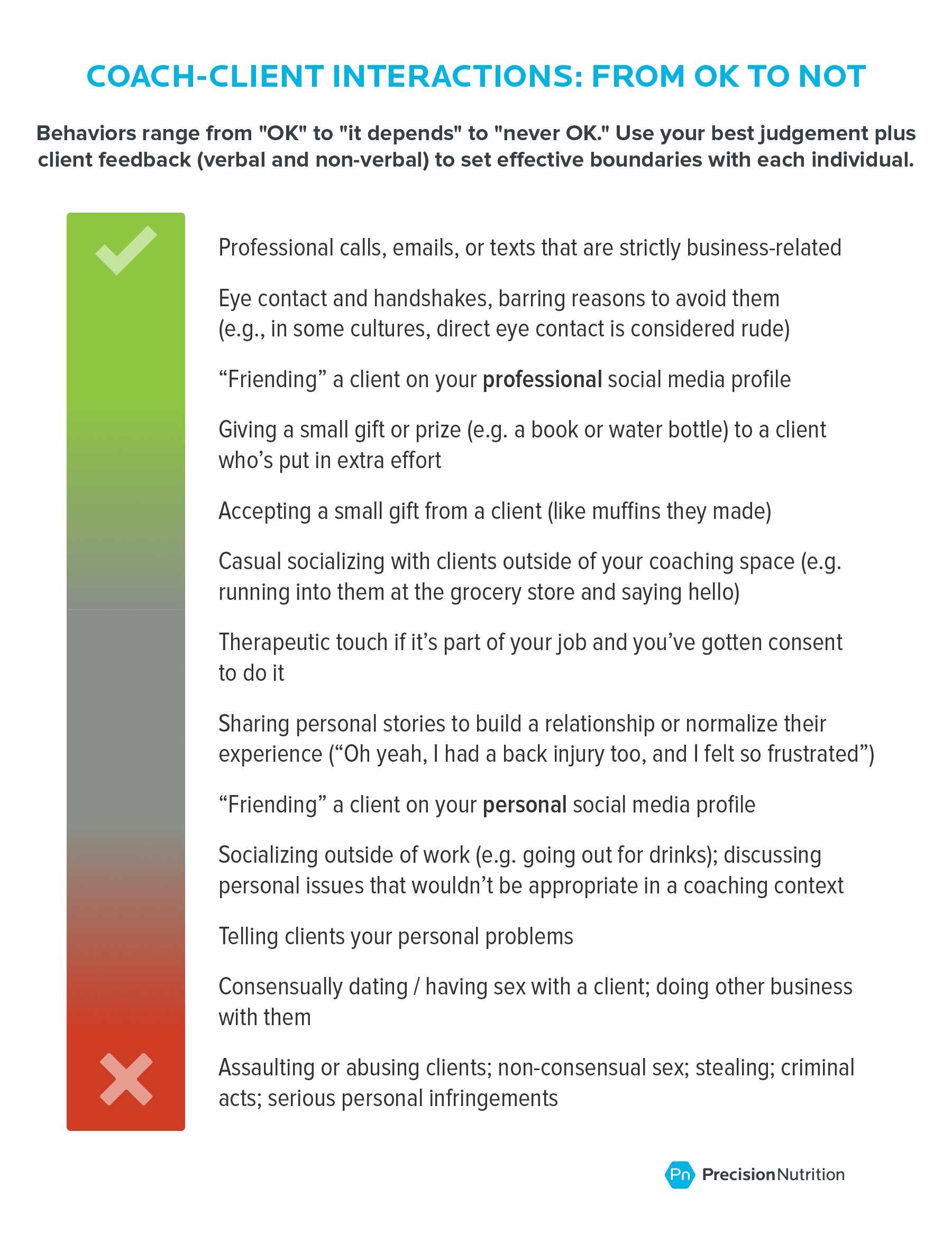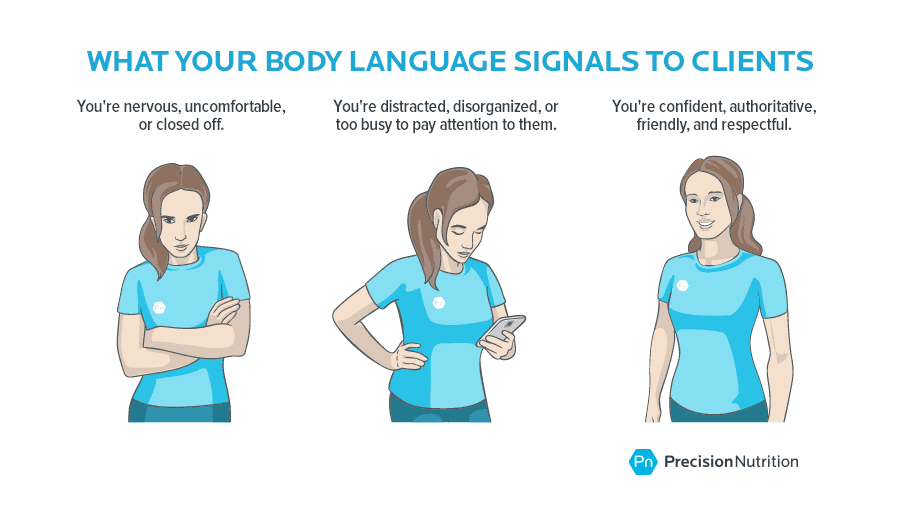What do you do when your client asks you out for a drink? Or texts at 2am? When you’re a health and fitness professional working closely with people who need your help, things can occasionally get awkward. Use this guide to set boundaries, while still creating a trusting coach-client relationship.
- Want to listen instead of read? Download the audio recording here…
++++
The details: A Precision Nutrition Certified coach—we’ll call her Sue—reached out to our private Facebook group for advice on a serious problem. Her client, also a coworker, had developed feelings for her.
Sue didn’t feel the same way.
She cared about this client and his goals. He’d already lost 50 pounds with her help.
But she didn’t want to be a caregiver or caretaker. His behavior had become an emotional drain.
When Sue tried to distance herself from the client, he lashed out and became self-destructive. His health habits regressed, and he went back to emotional eating.
As a coaching professional, Sue understood the dynamics. She knew the client’s reliance on her had become unhealthy. And she recognized that she herself was becoming more and more distressed.
Understandably, she felt stuck.
- She’d have to confront difficult feelings: The client would be upset.
- He’d regress: Asking him to change his behavior would cause a health-damaging backslide.
- She was also caught in conflicting close relationships: They work together every day.
Tricky situations like Sue’s are very common in health and fitness coaching.
Yet while therapists, psychologists, and doctors are formally trained to navigate the boundary issues that arise in client-practitioner relationships, fitness professionals often aren’t.
So consider this your crash course for conduct, complete with practical tools you can use now, no matter where you are in your career.
++++
The relationship between a client and a health practitioner is inherently intimate.
This is true whether you’re a strength coach, a group fitness trainer, a psychologist, a massage therapist, or a yoga instructor.
Deep feelings are discussed. Bodies are touched.
It’s “closeness,” even if it’s not romantic closeness.
As a result of this intimacy, it’s quite common (and natural) for coaches or clients to develop feelings (negative or positive) for each other. Feelings of friendship, tenderness, protectiveness, jealousy, anger, and/or frustration spill into the professional arrangement.
Without honesty and clear expectations, stuff gets messy.
Defining and upholding proper boundaries ensures that feelings don’t confuse the ultimate goal: to help the client achieve his or her health goals through self-empowered action.
When we don’t have well-defined and well-communicated roles, everyone is kinda standing around wondering, “What am I allowed to do here? And how are we supposed to interact?”
Anxieties, frustrations, and old hurts emerge, often vaguely and vexingly, and we feel pushed and pulled in many directions.
That’s why we need boundaries.
Boundaries are the invisible lines of division between the service provider and the client or patient, the social (and sometimes physical) norms and practices that define:
- who is playing what role (e.g. who is coach and who is client);
- what those roles involve (e.g. who provides direction and how); and
- what the limits of that professional relationship are (e.g. how available the coach is for the client, or what’s discussed in sessions).
Good boundaries mean that clients:
- feel safe and secure with their coaches, trusting they’ll act in their best interests.
- understand the care a coach shows is the universal care of an invested, compassionate professional, and not a sign of romantic interest (or some other attachment).
- are obligated to show up maturely and responsibly; to regulate their emotions, own their behaviors, and be consistent.
Good boundaries mean that coaches:
- avoid ethical breaches or working outside of our scope of practice.
- don’t take on more than our share of responsibility for client progress and change.
- show our clients clearly who is doing what, when, and how.
- recognize the potential power imbalance that is part of coaching, and respect our clients as autonomous individuals.
With clear boundaries, we have fewer misunderstandings and awkward situations.
Which is always good.
With well-defined, strong, healthy boundaries, our “emotional bank account” is freed up to invest in a robust coaching relationship that keeps us as coaches safe and sane, while helping clients reach their goals.
Appropriate (and also creepy) behavior is context-dependent.
- There’s a green zone: Totally cool almost all of the time. Like smiling and making eye contact as you greet a client.
- There are “gray zones”: A little more blurry, and depends on the context and nature of the relationship. Like hugging a client after they just did their first pullup.
- And there’s a red zone: Definitely—and always—a hard “no.” Like, “Don’t steal from clients” seems pretty intuitive.
But in real life, boundaries aren’t one-size-fits-all.
Therefore (and to make things more complex), the same action can be “green” with one client and “red” with another.
With a client you have a secure, trusting relationship with, it might be totally cool to exchange the odd gift.
But that newer client you suspect might be crushing on you? Exchanging gifts may send the wrong message and confuse the purpose of the relationship.

Context is everything.
With more experience, trust, and maturity you have more freedom—to get close, to joke, potentially to do or say “inappropriate” things.
With relationships that are newer, more fraught or confused, play by stricter rules.
In terms of ethical codes, health and fitness coaching is a little late to the party.
Other fields of service provision, such as psychology or social work, have clear codes of ethics they abide by.
Many mental and physical health care service providers receive ethics training as part of their certification, but coaches often don’t.
Yet part of your job as a coach is to behave ethically, which includes defining and maintaining clear boundaries.
So Precision Nutrition wrote its own Code of Ethics for the coaches we certify.
You can start with our Code of Ethics as a template, and add to it as you wish, according to your own value system, and the nuances of your practice.
PN Coaching Certification Code of Ethics
In your professional role as a coach:
Act in the client’s best interest. Prioritize their wellbeing, safety, values, goals, and comfort where possible.
Respect the worth and dignity of the clients you serve. Treat all clients with professional courtesy, compassion, and care.
Protect your clients’ privacy and confidentiality. This includes that you:
- Follow standard data security protocols, such as protecting your personal logins and storing client data securely.
- Be careful what you discuss about clients, and with whom.
- Do not disclose personal or identifying details of clients.
- Ask permission before sharing anything on social media.
Act with integrity. Make yourself worthy of your clients’ respect and trust. Don’t exploit your clients, financially or otherwise. Don’t seek personal gain from your client relationship (beyond your coaching fees, obviously).
Act with objectivity. Know the rules, regulations, and procedures expected of you, and follow them equitably and appropriately for each client.
Set clear, accurate, and reasonable expectations. Define the terms of the coaching arrangement (e.g. payment, frequency of meeting, how coaching works, etc.) immediately and reinforce them often. Be upfront about what results the client can realistically expect to see.
Have clear professional boundaries. Avoid multiple relationships (e.g. coaching friends or family members; becoming friends with clients) where possible. If you must have multiple relationships, recognize the inherent power imbalance in coaching, and be very clear what hat you’re wearing in a given situation.
Know the limits of your skills and scope of practice. If you can’t serve a client for reasons of ethics or expertise, refer them to another coach and/or care provider if possible.
Keep your skills current. Pursue professional competence, excellence, and mastery. Seek to be a credit to your profession.
8 ways to stay out of sticky situations.
For coaches, there are lots of ways identify, establish, and maintain boundaries in your professional practice. We’ve got 8 to get you started.
The more tools you use, the more clear, comfortable, and secure your relationships will be.
Plus, less awkward moments.
1. Pay attention to your “emotional radar.”
Often, when boundaries get pushed (or trampled on), your body will tell you.
For example, you might notice that around a certain client, you feel tense, “icky,” or even repelled.
If you observe those sensations, check in with yourself.
- Are roles defined and contracts clear?
- Are you being asked to do things (either implicitly or explicitly) that make you feel uncomfortable?
- Are you being exposed to some “TMI” material, either through the content of your client’s words, or images they sent to you?
If you can identify what’s bothering you, work to fix the situation:
- Model appropriate behavior.
- Communicate clearly, assertively, and maturely. (Keep reading for ideas on how to do this.)
- Inform others about your boundaries and expectations for the working relationship. Don’t assume people “should just know” what appropriate behavior is. They might not.
2. Use body language to manage the space between you and your clients.
We “say” a lot without actually saying it.
Humans have a sort of sixth sense when it comes to expressing and reading body language. What we do with our bodies, and what others do, is worth a thousand words.

That means you can actually use your body as a tool to shape the coach-client relationship.
You can use your nonverbal cues to steer or “lead” clients.
For example, if a client is getting a little too close, you can lean or step back a little to increase the distance between you, or put an object between you (such as a desk or bench).
Without using words, this suggests, “This is a better amount of space between us.”
Other times, you may want to encourage closeness.
One simple way to do this is by “mirroring” your clients’ movements (subtly), and making eye contact. This demonstrates your attention and presence, and can foster a feeling of connection.
To convey confidence and authority, stand or sit tall, with good, but relatively relaxed posture. You’ll look like someone worth respecting and listening to.
3. Use your voice to show the right balance of care and authority.
Voices are powerful.
Your voice can command, cajole, calm, or control—and it can help you set and maintain boundaries too.
Generally, a warm, yet professional tone will signify interest and authority.
Speak clearly at a moderate pace, and unless you’re actually asking a question, be careful of a tendency to use a rising tone at the end of a sentence. (Which will make everything sound like a question? And it’ll imply that you don’t need to be taken seriously?)
Match your voice volume and cadence to your client’s to show attunement.
You can also use your voice to steer someone gently if you feel things should be going in a different direction: talking slower and lower to a client who’s gotten worked up and is talking fast and loud; speaking gently to a client who’s intimidated, scared, or defensive; or speaking firmly and clearly to a client who’s gotten a little too… friendly.
4. Write like a pro (or at least a good middle school student)
Even if your main jam is one-on-one sessions with clients, talking in an office or on a gym floor, you’ll probably do a fair bit of writing too: in emails or texts, handouts, contracts, and signs on the wall.
Your professional image is reflected in your writing, so cover the basics: Use proper punctuation, check your spelling, and get your message across clearly and concisely.
Make sure signs are clearly displayed and contracts are reviewed and understood, ideally before you begin your coaching relationship.
Signs and contracts tell clients what to expect, what their responsibilities are, and what you’re here for (and not here for). Articulate this up front, and you’ll have fewer problems later.
5. Make informed consent an ongoing conversation.
If you’ve ever joined a gym, had a massage, received psychotherapy, or joined a sports team, you might have had to go through some kind of informed consent and waiver-signing process.
An informed consent form usually covers things like scope of services and liability, and the potential risks to clients. It’s a good idea for every coaching practice to have one.
But it doesn’t have to stop there.
If made an ongoing conversation, the informed consent process can be an awesome, useful tool that helps define boundaries and helps clients feel heard, respected, and comforted.
Check in with your client on consent topics every few weeks. You can organize the conversation around themes like:
- What’s happening for you as a client right now? Can you give me a “status update” about how you feel / think about our process, or your current situation?
- Are you OK with what’s happening now? Does this match what you expected or wanted? Would you feel more comfortable doing something differently?
- Do you understand what’s happening now? Do you as a client, comprehend why we’re doing something, and/or what the risks and benefits are? Do you understand how this activity connects to your goals?
- Do you want to continue in this direction? Or do you need a break? Informed consent includes the client knowing that they have the right to say no to anything the coach proposes.
6. Protect your time.
Pop quiz: If a client texts you at 2am, do you respond?
Clients may email, text, or even call at all hours of the day or night. While you can have your business hours clearly displayed on your website, contracts, or signs around your office, clients may still pop in when it’s convenient for them.
That’s OK. (So long as they’re not banging on the door of your personal home at midnight. That’s “red zone” material.)
When and how quickly you respond to clients signals to them what you will accept, and what they should expect.
For example, if you start answering emails at 10:30 at night, a client may expect you to be available during those hours. If you always respond to texts within three minutes, a client may expect nearly immediate answers from you.
You get to decide what your boundaries are here, and what you’re comfortable with. If you don’t want your evenings to be crowded out by client emails, then turn the computer off before dinner, and respond to them in the morning.
Similarly, you get to set the tone for how time is spent during your in-person time with clients.
If a client is consistently late or missing appointments, or if they keep directing the conversation to who they went out with on the weekend instead of how their food journaling went, then it’s your job to gently but firmly call them out.
Sometimes an adult conversation needs to happen.
Like:
“Hey, I’ve noticed that you’ve been 20 minutes late for the last three appointments. Is this still a good time for you? If it is, let’s agree to start our session on time so we don’t have to cut into your appointment time.”
Or:
“It sounds like you had a fun weekend! But hey, I’d love to talk about your nutrition. I know one of your goals is to eat better, and I’m curious to know about how you’ve been doing. The more we focus our conversation, the better we can get both of our needs met.”
Approach these conversations as if you and your client are on the same team, rather than adversaries. Be friendly, and focus on the win you both want!
7. Dress sharp.
One perk of being a coach: You get to dress comfy!
One downside of being a coach: You get to dress comfy! Which means that sometimes, it’s hard to know what looks appropriate and also helps you demonstrate a squat or run a few agility ladders.
However, if you choose carefully, you can convey professionalism in athletic gear.
If you look professional, your clients will be less likely to treat you as a buddy or a potential hookup, and more likely to treat you as, well, a professional.
Make sure your clothes are clean and well-maintained, and that all your, um, parts are contained.
Your dress should also be appropriate to your environment. If you work at a gym, gym clothes are good. If you work in an office, “business casual” is likely the better dress code.
8. If physical contact is necessary, check in with your client’s experience of it often.
If you’re a personal trainer, massage therapist, yoga teacher, chiropractor, etc., body work is part of your job.
Make sure to have clients sign a form that provides consent to touch.
Even with contracts signed and squared off, always ask your clients for permission before you touch them, especially in potentially awkward or vulnerable areas. (This is especially important in situations where touch could be misinterpreted—for instance, a male personal trainer touching a female client’s glutes.)
If you’re a coach, here’s a handy checklist for considering boundaries when touching your client.
- Does touching my client make sense in the context of our professional relationship? Am I, for example, a massage therapist or personal trainer legitimately touching my client in particular ways?
- Does touching my client raise any issues given our social identities? That’s a fancy way of saying who are you, and who are they? Are you male, female, older, younger, the coach, the client (and so on)?
- Does touching my client make sense in a cultural or social context? Different cultures have different norms on touch. And “culture” can be anything. For instance, your local MMA gym may consider it perfectly normal to choke someone with your thighs… but that’s not a good look at your average gym.
- What are the benefits to touching my client? Am I helping teach them an exercise, giving them useful feedback, creating a genuine personal connection, and/or calming them?
- What are the potential risks to touching my client? Might I be invading their boundaries, making them feel less comfortable, or sending signals that could be misinterpreted?
- What are my motivations for touching my client? Is this to benefit them, or me?
- Do I know my client’s personal history or level of comfort with touch? Some people have a history of physical or sexual abuse, or simply aren’t that comfortable being touched. Since you likely don’t know all clients’ personal details, start by assuming your client may have some kind of discomfort with touching. Proceed slowly with caution and assess their comfort as you go.
- How am I letting my client know what to expect? A simple way to judge comfort is just to announce, then ask. For example, “I’m going to put my hand just underneath your left armpit to feel if your lat muscles are engaged. Is that OK?”
- What feedback am I getting? Read body language, and ask. If your client gives you a hearty handshake with a bro-back-slap while making eye contact and smiling, you’re probably good to do the same. If you hug them and they shrink back or go rigid, quit hugging them.
- Have alternatives handy. If you’re trying to give a client proprioceptive feedback, you can often use some neutral object (like having their butt hit a wall when you’re teaching a hip hinge). If hugging is a no, you may be able to do a less-threatening touch of the upper arm, or just work your smile and wave game.
And this should go without saying, but we’re gonna say it anyway:
For heaven’s sake, don’t touch your clients inappropriately. If you don’t know what constitutes consent or assault, educate yourself.
What to do next
When your “boundary radar” goes off, pay attention.
Don’t wait or avoid a situation that’s bothering you.
If you do, it’ll often get worse.
Prevention is the best option here, but if that hasn’t worked, then sometimes you’ll need to deal directly with an uncomfortable situation.
If possible, prepare documentation—such as emails, text messages, or a written summary of what happened from your perspective—or discussion topics in advance, and consider your overall strategy before having a difficult conversation.
Remember: You never have to work with someone who’s abusive, aggressive, or otherwise violates your boundaries.
Whether it’s a persistent series of misunderstandings and misalignments; someone who constantly gives you the “ugh” or “uh-oh” feeling; or outright harassment, you never have to tolerate a physically or psychologically harmful situation.
Get out or refer out.
Are you ready to go from a skilled coach to an exceptional one? The PN Level 2 Master Health Coaching Certification is your opportunity to do just that.
This 20-week program is designed for coaches who are committed to mastering real-world coaching. It’s not just about knowledge—it’s about applying it to make a difference in your clients' lives.
This is NOT a "Level 2" nutrition course. It's NOT about meal plans or macros. It’s an advanced training program that prepares you to:
🔑 Understand your clients on a deeper level, beyond food and fitness, and help them make real, lasting changes.
🔑 Coach with confidence through complex situations like mental health, stress, and emotional setbacks.
🔑 Master behavior change so your clients stay committed—no matter what life throws their way.
It’s the only program of its kind that combines self-paced learning, weekly live mentorship, and real-world coaching practice.
Plus, Level 2 program is NBHWC-approved, meaning graduates are eligible to pursue board certification through the National Board for Health & Wellness Coaching (NBHWC) or professional membership with the Health Coaches Alliance (HCA).
That’s a big deal. These credentials open doors, expand career opportunities, and help you stand out in a growing field.
References
Click here to view the information sources referenced in this article.





Share